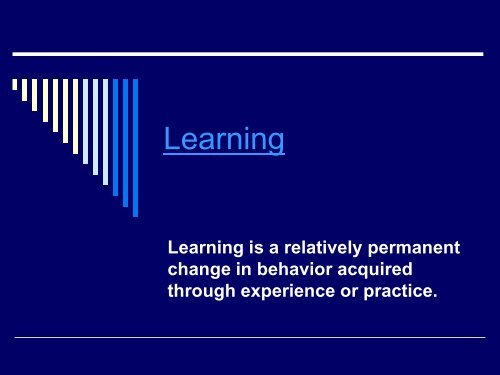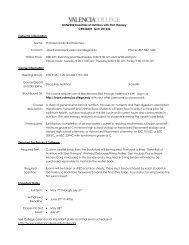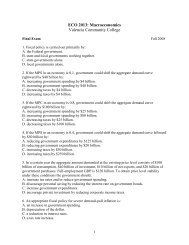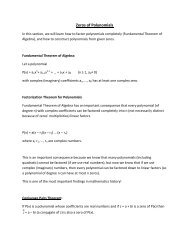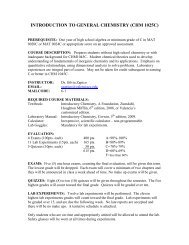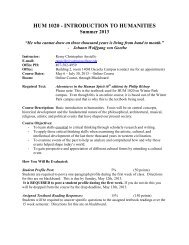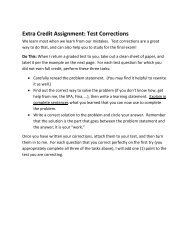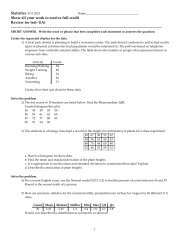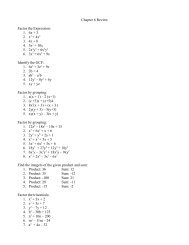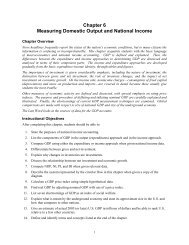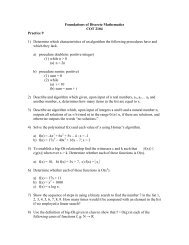Ciccarelli Chapter 5 - Learning
Ciccarelli Chapter 5 - Learning
Ciccarelli Chapter 5 - Learning
You also want an ePaper? Increase the reach of your titles
YUMPU automatically turns print PDFs into web optimized ePapers that Google loves.
<strong>Learning</strong><strong>Learning</strong> is a relatively permanentchange in behavior acquiredthrough experience or practice.
What is <strong>Learning</strong>? <strong>Learning</strong> is the process that allows us to adapt(be flexible) to the changing conditions of theworld around us. We (I) can alter our (my)actions until we (I) find the behavior that leadsus (me) to survival and rewards, and we (I) caneliminate actions that have been unsuccessfulin the past. **Psychologists believe that for learning tooccur, changes in behavior must be enduring.Likewise, it is believed that when learningoccurs, there is a physical change that occursin our brain to denote that “new learning”.
3 Major Schools of <strong>Learning</strong> 1) **Classical conditioning – Is the process of learningby which a previously neutral stimulus comes to elicitan identical or similar response to one originallyelicited by the unconditioned stimulus as the result ofthe pairing of the two stimuli. 2) **Operant conditioning – Is the process of learningin which the manipulation of the consequences of aresponse influences the probability of the responseoccurring. 3) **Cognitive learning – Is learning that occurswithout the opportunity of first performing the learnedresponse or being reinforced for it.
Classical Conditioning – <strong>Learning</strong>through Association Ivan Pavlov discovered the form of learningcalled Classical Conditioning. ClassicalConditioning is learning by association. Unconditioned means unlearned or naturallyoccurring. Therefore, a stimulus that elicits anunconditioned response (UCR) is called anunconditioned stimulus (UCS). A neutralstimulus (NS) is a stimulus that does notnaturally elicit a response. After repeatedpairings of the NS with the UCS, the NS istransformed to a CS bringing about a CR.
<strong>Learning</strong> The repeated pairing of the NS and theUCS is called __________________,because the organism is in the processof acquiring learning. Any event or object that, when followinga response, increases the likelihood ofthat response occurring again iscalled_________________.
Extinction Extinction is the gradual weakening andeventual disappearance of a conditionedresponse. Spontaneous recovery – is the spontaneousreturn of a conditioned response followingextinction. Reconditioning - is the process of relearning aconditioned response following extinction. Stimulus generalization - is the tendency forstimuli that are similar to the conditionedstimulus to elicit a conditioned response.
Stimulus discrimination – is the tendency todifferentiate among stimuli so that stimuli thatare related to the original conditioned stimulus,but not identical to it, fail to elicit a conditionedresponse. Higher-order conditioning – is when a newstimulus becomes a conditioned stimulus whenit is paired with an established conditionedstimulus that already elicits the conditionedresponse. See p. 183, fig. 5.4.
Factors that StrengthenConditioned Responses Frequency of pairings – the more often the CSis paired with the US, the stronger and morereliable the conditioned response will be. Timing – the strongest conditioned responsesoccur when the CS is presented first andremains present throughout the administrationof the US. Intensity of US – A stronger US will typicallylead to faster conditioning than a weaker one.
A Cognitive Perspective onClassical Conditioning Psychologist Robert Rescorla argued thatconditioning depends on the informational value thatthe conditioned stimulus acquires in _____________the occurrence of the unconditioned stimulus.According to Rescorla, people actively seekinformation that helps them predict the occurrence ofimportant events in their environment. Conditioned emotional response – is an emotionalresponse to a particular stimulus acquired throughclassical conditioning. The classical conditioning of a reflex response oremotion by watching the reaction of another person iscalled_______________________.
___________ is a form of therapy that involves thesystematic application of the principles of learning. Conditioned taste aversions – refers to aversions toparticular tastes acquired through classical conditioning;e.g., Researchers found that rats that were given asweetened liquid and then injected with a drug orexposed to radiation that caused __________________would not touch the liquid again. Conditioned tasteaversions is an example of ____________________________________ which refers to the tendency ofanimals to learn certain associations, such as taste andnausea, with only one or few pairings due to the survivalvalue of the learning. What is it that you perhaps shouldhave a conditioned taste (habit) aversion to?
The Concept 0f Reinforcement Operant – Is any behavior that is _______________. The basis of operant conditioning is the effect of____________________ on behavior. Any event or stimulus, that when following a response,increases the probability that the response will occuragain is ________________. Any event that is naturally reinforcing by meeting abasic biological need, such as hunger, thirst, or touchis called________________. Any reinforcer that becomes reinforcing after beingpaired with a primary reinforcer, is called______________________.
Radical BehaviorismRadical behaviorism argues that the philosophical position ofhaving “free will” is an illusion or myth and that human andanimal behavior is completely determined by environmental andgenetic influences. For Skinner, the mind was a “black box”whose contents cannot be illuminated by science. For Skinner,behavior is shaped by its consequences.Reinforcer – is any stimulus event that increases the likelihoodthat the behavior it follows will be repeated. Skinner coined theterm operant conditioning to describe the process of learning bywhich responses are strengthened through manipulating theeffects or consequences that follow them. Through this formof learning, organisms learn responses that producepositive or rewarding effects. The responses themselves arecalled operants because they operate on, or act upon, theenvironment.Superstitious behavior is behavior acquired through coincidentalassociation of a response and a reinforcement.
Principles of OperantConditioningDiscriminative Stimuli – is a cue that signals that reinforcementis available if the subject makes a particular response.Positive Reinforcement – is the strengthening of a responsethrough the ___________of a stimulus following the response.Negative Reinforcement – is the strengthening of a responsethrough the _____________ of a stimulus after the responseoccurs.Primary reinforcers – are intrinsically rewarding because theysatisfy basic biological needs or drives, e.g., food, water sleepsexual stimulation etc.Secondary reinforcers – are learned reinforcers that developtheir reinforcing properties because of their association withprimary reinforcers, e.g., money because it can be exchangedfor more basic reinforcers.
Positive and NegativePunishment Any event or object that, when followinga response, makes that response lesslikely to happen again iscalled_________________. The punishment of a response by theaddition of an unpleasant stimulus iscalled __________________. The punishment of a response by theremoval of a pleasurable stimulus iscalled ____________________.
The Effects of UsingPunishment Punishment – 1) It serves to temporarilysuppress or inhibit a behavior until enough timehas passed. 2) Severe punishment stops theunwanted behavior immediately. It may not stopit permanently, but it does stop it. 3) Severepunishment can lead to abuse. 4) Severepunishment may cause the child to avoid the___________ instead of the behavior beingpunished, so the child learns the wrongresponse. 5) Severe punishment mayencourage ______________ to avoid thepunishment again, not the response that isdesired.
The Effects of UsingPunishment 6) Severe punishment creates_________ and ___________,emotional responses that do not promotelearning, e.g., Michael Jackson/JoeJackson. 7) Hitting provides a successfulmodel for aggression. ** It may send themessage to children that hitting is anacceptable way of resolvinginterpersonal conflict.
Making Punishment MoreEffective 1. Punishment should immediately followthe behavior it is meant to punish. 2. Punishment should be consistent. Neversay, “I’m going to kill you!” 3. Punishment of the wrong behavior shouldbe paired with reinforcement of the rightbehavior. 4. Punishment is more effective when it iscombined with positive reinforcement fordesirable alternative behavior.
Shaping – is a process of learning that involves thereinforcement of increasingly closer approximations ofthe desired response. Method of successive approximations – is the methodused to shape behavior that involves reinforcing evercloserapproximations of the desired response. Discriminative stimulus – Any stimulus that provides theorganism with a cue for making a certain response inorder to obtain reinforcement. Schedules of reinforcement – is a predetermined plan fortiming the delivery of reinforcement- influence learning. Schedule of continuous reinforcement – is a system ofdispensing a reinforcement each time a correct responseis produced. However, continuous reinforcement alsoleads to rapid extinction when reinforcement is withheld.
Schedule of partial reinforcement – is a dispensinga reinforcement for only a portion of responses; thismakes responses more resistant to extinction. Partial reinforcement is administered under twogeneral kinds of schedules: ratio schedules andinterval schedules. In ratio schedules, reinforcementis based on the number of responses. In intervalschedules, reinforcement is based on the timing ofresponses. Within each type, reinforcement can beadministered on either a fixed or variable basis. It isthe unpredictability of the variable schedule thatmakes the responses more or less continuous.
In a fixed-ratio schedule, reinforcement is givenafter a specified number of correct responses.In a variable-ratio schedule, the number ofcorrect responses needed before reinforcementis given varies around some averagenumber.**________________________typically produce high, steady rates ofresponse. They are also more resistant to________________ than fixed-ratio schedules.
In a fixed-interval schedule, reinforcement is given onlyfor a correct response made after a fixed amount of timehas elapsed since the last reinforcement. Whereas, in avariable-interval schedule, the amount of time that mustelapse before reinforcement can be given for a correctresponse is variable rather than fixed. There are biological constraints on operant conditioning.Generally speaking, animals come into the world withcertain genetically determined instinctive patterns ofbehavior already in place. Instinctive drift – tendency for an animal’s behavior torevert to ___________________ controlled patterns ofbehavior. Instinctual behavior is genetically determinedand not under the influence of learning.
Applying Operant Conditioning:Behavior Modification The use of operant conditioning techniquesto bring about desired changes in behavioris called__________________. The type of behavior modification in whichdesired behavior is rewarded with tokens iscalled _________________. The modern term for a form of behaviormodification that uses shaping techniquesto mold a desired behavior or response iscalled __________________________.
Cognitive <strong>Learning</strong> Cognitive learning involves mental processesthat cannot be directly observed-processes likethinking, information processing, problemsolving, and mental imaging. Insight learning – involves the process ofmentally working through a problem until thesudden realization of a solution occurs. Latent <strong>Learning</strong> – is learning that occurs withoutapparent reinforcement and that is notdisplayed until its application becomes needed.
The tendency to fail to act to escape from asituation because of a history of repeated failures inthe past is called_____________________. Twocrucial elements appear to be present with this typeof learning. They are: _____________________________and _______________________________. Cognitive map – is a mental representation of anarea that helps an organism navigate its way fromone point to another. <strong>Learning</strong>/performance distinction – <strong>Learning</strong> cantake place by observation alone; without the actualperformance. Observational learning – is learning by observingand imitating the behavior of others, also calledvicarious learning or modeling.
The Four Elements ofObservational <strong>Learning</strong> 1. Attention/ mentally able 2. Memory/ mentally able 3. Imitation/ physically able 4. Motivation/ emotionally wants to 5. People pay more attention to thosepersons perceive as similar to them andto people whom they perceive asattractive; intellectually, financially,spiritually, etc.
Applying Reinforcement 1. Be specific 2. Use specific language 3. Select a reinforcer 4. Explain the contingency 5. Apply the reinforcer immediately 6. Track the frequency of the desiredbehavior. Wean the child from the reinforcer – After thedesired response is well established, graduallyeliminate the reinforcer but continue usingsocial reinforcement (e.g. praise) to maintainthe behavior.
Giving Praise1. Make eye contact with the child and smile when givingpraise.2. Use hugs.3. Be specific, connect praise with the desired behavior.4. Be sincere.5. Avoid empty flattery.6. Reward the effort, not the outcome.7. Avoid repeating yourself, elaborate on your praise, have arepertoire of praise.8. Don’t, Don’t, Don’t’ end on a sour note. The End STUDY STUDY STUDY
Punishment as a method ofDiscipline Punishment may temporarily ____________ undesirablebehavior, but it doesn’t eliminate it; and the punishedbehavior often returns when the punishing stimulus iswithdrawn. Drawbacks to using punishment: (1)punishment does not teach new behaviors; (2)punishment can have undesirable consequences; (3)punishment may become abusive - persons at timescrosses the line between discipline and abuse; and (4)punishment may represent a form of inappropriatemodeling. Children may learn that using force is anacceptable way of resolving interpersonal problems. Escape learning is learning of behaviors that allow anorganism to escape from an aversive stimulus. While,avoidance learning is learning of behaviors that allow anorganism to avoid an aversive stimulus
Punishment is the introduction of anaversive stimulus or the removal of areinforcing stimulus after a responseoccurs, which leads to the weakening orsuppression of the response


